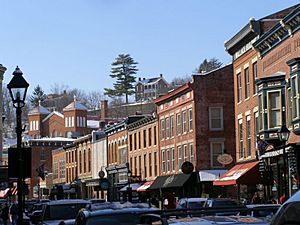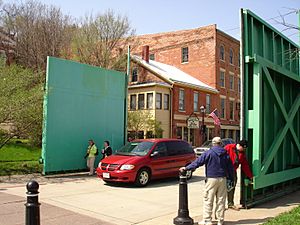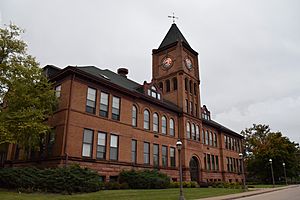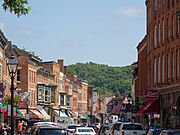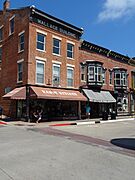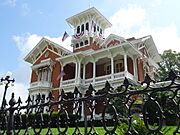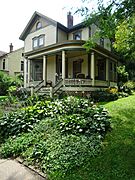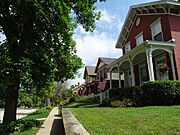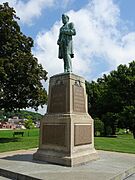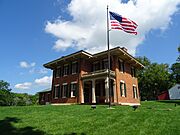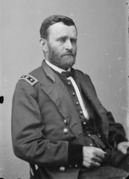Galena, Illinois facts for kids
Quick facts for kids
Galena, Illinois
|
|||
|---|---|---|---|
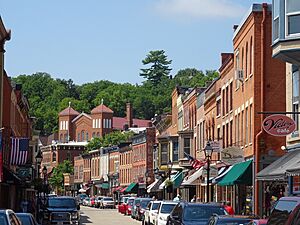
Main Street
|
|||
|
|||
| Etymology: Galena ore | |||

Location of Galena in Jo Daviess County, Illinois
|
|||
| Country | United States | ||
| State | Illinois | ||
| County | Jo Daviess | ||
| Township | East Galena, West Galena, and Rawlins | ||
| Settled | 1690s (French) | ||
| Founded | 1826 | ||
| Incorporated | 1835 | ||
| Chartered | 1841 | ||
| Government | |||
| • Type | Galena City Hall | ||
| Area | |||
| • Total | 4.51 sq mi (11.67 km2) | ||
| • Land | 4.50 sq mi (11.65 km2) | ||
| • Water | 0.01 sq mi (0.02 km2) | ||
| Elevation | 633 ft (193 m) | ||
| Population
(2020)
|
|||
| • Total | 3,308 | ||
| • Density | 736.4/sq mi (284.3/km2) | ||
| Time zone | UTC-6 (North American Central (CST)) | ||
| • Summer (DST) | UTC-5 (CDT) | ||
| ZIP Code(s) |
61036
|
||
| Area code(s) | 815 | ||
| FIPS code | 17-28300 | ||
| Wikimedia Commons | Galena, Illinois | ||
| Website | http://www.cityofgalena.org/ | ||
Galena is the biggest city in Jo Daviess County, Illinois, United States. It is also the county seat. In 2020, about 3,308 people lived there. A large part of the city, about 581 acres, is a special historic area. It is called the Galena Historic District. The city gets its name from a mineral called galena. This mineral was important for the area's early lead mining.
Long ago, Native Americans mined galena here. Tribes like the Meskwaki, Ho-Chunk, Sauk, and Menominee mined it for over a thousand years. When European Americans arrived, Galena became the site of the first big mineral rush in the U.S. By 1828, about 10,000 people lived here. This was almost as many as in Chicago at that time! Galena also became a major steamboat center on the Mississippi River. It was the biggest one north of St. Louis.
Galena was once home to Ulysses S. Grant and eight other generals from the American Civil War. Today, Galena is a popular place for tourists. People visit for its history, old buildings, and fun resorts.
Contents
History of Galena
Early History and Lead Mining
The city is named after galena. This is a natural form of lead sulfide (PbS). It was the most important ore for lead. Native Americans used to mine this ore. They used it in burial ceremonies. The Havana Hopewell culture traded galena a very long time ago, between 1 and 400 CE. Later, during the Mississippian culture (900–1500 CE), galena was used for body paint.
The French first learned about lead deposits in the Upper Mississippi Valley in 1658. A French map from 1703 showed this area as "mines de plumb" (lead mines). When the French arrived, the area was home to the Sac and Fox tribes. In the 1690s, French trappers found the lead and started mining. But fighting with the Sioux tribe stopped large-scale mining. This changed when Julien Dubuque's Mines opened in 1788.
The French called Galena La Pointe. Early Americans also used this name, calling it "The Point". Some old papers call it "Fever River," which was an early name for the Galena River. In 1816, George Davenport sent Galena's first boatload of lead ore down the Mississippi River. Three years later, Jesse W. Shull built a trading post. The Thomas H. January family arrived in 1821. They are thought to be the first permanent American settlers. In 1822, the U.S. Department of War took control of the mines. They started leasing the land for mining. A big group of settlers came in 1823. Steamboat trade began in 1824.
Galena's Boomtown Years
The U.S. government first leased the mines to James Johnson in 1822. In 1824, Martin Thomas was put in charge of mine leases. He surveyed the mines in 1826. The name "Galena" was chosen at a town meeting that year. Other names like Jackson and Harrison were not picked. Thomas planned out the town. Starting in June 1827, people could lease plots of land from the government. The government owned the land until 1836–37.
When Jo Daviess County was created in 1827, Galena became its county seat. This meant Galena got its first courts. Before this, legal issues were handled by the Superintendent of Lead Mines. From 1825 to 1828, 21 million pounds of lead were mined in Galena. The population grew from 200 to 10,000 people in that short time!
Local tribes, mostly Winnebago, allowed settlers to mine in certain areas. But as the city grew, settlers started mining on Native American lands. After a pioneer family was killed near Prairie du Chien, Wisconsin, Galena closed its mines. People got ready for war. Forts were built nearby at Elizabeth and Apple River. These forts helped people feel safe. The Winnebago War was a small conflict. After it, the U.S. took control of the lands near the city in 1829.
Galena's first fire department started on February 1, 1830. On September 7, 1835, residents voted to become an official town. Eight days later, five people were chosen as the first leaders. The town was officially approved on October 2. On May 22, 1837, a steamboat was chosen as the town's symbol. In 1841, Galena held its first elections for mayor and aldermen. Charles S. Hempstead became the first mayor. A census that year counted 1,900 people.
By 1845, Galena was producing almost 27,000 tons of lead ore. Jo Daviess County produced 80 percent of all lead in the United States. Galena was once one of the most important cities in Illinois. It was a busy hub on the Mississippi River between St. Louis and St. Paul. Over time, the Galena River became too shallow for steamboats. Galena became famous in the 1860s as the home of General Ulysses S. Grant.
Galena Today
After the demand for lead dropped, Galena's population went down. It fell from 14,000 in the mid-1800s to about 3,300 today.
Galena's official flag was chosen in 1976. It shows symbols for mining, agriculture, steamboats, and the nine American Civil War generals who lived in the city.
The Country Fair in Grant Park helped Galena become a tourist town. It is a craft show that brings many visitors. Main Street's old buildings have also been fixed up. In 2010, Galena started a plan called Vision2020. This plan helps the community decide what they want Galena to achieve in the next decade. The annual Halloween Parade in 2010 had about 15,000 people! In 2011, TripAdvisor named Galena one of its top-ten "Charming Small Towns."
Geography of Galena
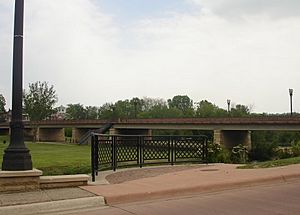
Galena is located at 42°25′5″N 90°25′53″W / 42.41806°N 90.43139°W. It sits along the Galena River. This river flows into the Mississippi River.
In 2010, Galena had a total area of about 4.167 square miles. Almost all of this (99.83%) is land. Only a tiny part (0.17%) is water.
Galena is in the Driftless Zone. This is a special area that was not covered by glaciers during the last ice ages. Most of Illinois was covered, but this corner was not. Because of this, the area has many hills, valleys, bluffs, and exposed rocks.
Horseshoe Mound is a hill outside Galena. U.S. Route 20 winds around it before entering the city. The view from Horseshoe Mound is very popular for photos. It is 1063 feet above sea level.
 |
Menominee | Hazel Green, Wisconsin | Scales Mound |  |
| Mississippi River | The Galena Territory | |||
| Mississippi River | Hanover | Elizabeth |
Galena's Climate
Galena has a humid continental climate. This means it has cold winters and hot summers. It experiences all four seasons. About 36 inches of rain fall each year.
| Climate data for Galena | |||||||||||||
|---|---|---|---|---|---|---|---|---|---|---|---|---|---|
| Month | Jan | Feb | Mar | Apr | May | Jun | Jul | Aug | Sep | Oct | Nov | Dec | Year |
| Record high °F (°C) | 59 (15) |
69 (21) |
85 (29) |
88 (31) |
92 (33) |
101 (38) |
101 (38) |
102 (39) |
94 (34) |
91 (33) |
77 (25) |
68 (20) |
102 (39) |
| Mean daily maximum °F (°C) | 28 (−2) |
34 (1) |
45 (7) |
60 (16) |
70 (21) |
80 (27) |
83 (28) |
82 (28) |
74 (23) |
62 (17) |
47 (8) |
33 (1) |
58 (15) |
| Mean daily minimum °F (°C) | 10 (−12) |
14 (−10) |
25 (−4) |
36 (2) |
46 (8) |
56 (13) |
60 (16) |
58 (14) |
48 (9) |
37 (3) |
27 (−3) |
15 (−9) |
36 (2) |
| Record low °F (°C) | −33 (−36) |
−35 (−37) |
−14 (−26) |
12 (−11) |
21 (−6) |
33 (1) |
39 (4) |
37 (3) |
19 (−7) |
10 (−12) |
−2 (−19) |
−29 (−34) |
−35 (−37) |
| Average precipitation inches (mm) | 1.13 (29) |
1.58 (40) |
2.23 (57) |
3.53 (90) |
3.94 (100) |
5.00 (127) |
3.72 (94) |
4.49 (114) |
3.29 (84) |
2.95 (75) |
2.85 (72) |
2.04 (52) |
36.75 (934) |
| Source: The Weather Channel | |||||||||||||
Flooding in Galena
Because Galena is close to the Galena River, buildings have often been in danger of flooding. Frank Einsweiler built a dike to help stop floods. The bridge for Highway 20 over the river is named after him. In 1951, city floodgates were added to connect to the river levee system. This helped protect the city.
Here are some major floods Galena has seen:
- 1828: This was Galena's first recorded flood. The water was so high that steamboats could travel on the city streets!
- 1937: A flood covered Main Street with up to five feet of water. This caused serious damage to downtown buildings.
- 1972: A storm caused the floodgates to close. But the river still flooded the sewage plant. This backed up sewers. Sandbags were used to keep water from flooding downtown.
- 1993: Almost eight feet of water threatened downtown Galena. But the city's floodgates stopped it. Heavy spring rains caused the Mississippi and Galena Rivers to reach very high levels.
- 2010: On July 22, eight inches of rain fell in one night. The river swelled to twice its normal size. The floodgates saved downtown, but many businesses and homes had basement damage. If the gates hadn't been there, Main Street would have been under six feet of water. Damages were about $7–8 million. President Obama declared the county a disaster area.
- 2011: Between July 27 and 28, Galena got 10 to 15 inches of rain in 12 hours. The Galena River rose to more than double its normal height. It might have been the highest level since the floodgates were built. The Grant Park sign, from the 1800s, was washed away. Downtown businesses, trails, and roads had major damage. Early estimates for damage were around $16 million.
Population and People
| Historical population | |||
|---|---|---|---|
| Census | Pop. | %± | |
| 1850 | 6,004 | — | |
| 1860 | 8,196 | 36.5% | |
| 1870 | 7,019 | −14.4% | |
| 1880 | 6,451 | −8.1% | |
| 1890 | 5,635 | −12.6% | |
| 1900 | 5,005 | −11.2% | |
| 1910 | 4,835 | −3.4% | |
| 1920 | 4,742 | −1.9% | |
| 1930 | 3,878 | −18.2% | |
| 1940 | 4,126 | 6.4% | |
| 1950 | 4,648 | 12.7% | |
| 1960 | 4,410 | −5.1% | |
| 1970 | 3,930 | −10.9% | |
| 1980 | 3,876 | −1.4% | |
| 1990 | 3,647 | −5.9% | |
| 2000 | 3,460 | −5.1% | |
| 2010 | 3,429 | −0.9% | |
| 2020 | 3,308 | −3.5% | |
| U.S. Decennial Census | |||
Galena's Population in 2020
In 2020, Galena had a population of 3,308 people. The city had about 736 people per square mile. There were 2,008 homes. Most people (87.5%) were White. About 10.5% of the people were Hispanic or Latino.
Galena's Population in 2010
In 2010, there were 3,429 people living in Galena. There were 1,632 households. About 20.8% of households had children under 18. Most households (42%) were married couples. The average age in the city was 44.7 years.
The average income for a household in Galena was $45,409. For families, it was $53,438. About 7.9% of the population lived below the poverty line. This included 13.8% of those under 18.
Culture and Tourism
Galena is home to the Galena Art Center. It also has the Galena Arts and Recreation Center. Turner Hall is a building from the 1800s. It has been fixed up and is now used for shows and weddings. Galena also has several historic sites owned by the State of Illinois. These include the Old Market House and the Ulysses S. Grant Home. The Galena/Jo Daviess County Historical Society also owns historical sites. These include the Galena and U.S. Grant Museum.
Galena hosts many big events each year. The annual Halloween Parade brings thousands of people.
Visiting Galena
Galena is a very popular place for tourists. Over a million people visit each year. Many people from Chicago have second homes here. Galena is popular because it has historic streets you can walk on. This is rare for American cities.
City Layout and Historic Charm
About 85% of Galena's buildings are in the Galena Historic District. This area is listed on the National Register of Historic Places. This makes the city very popular. The Old Market House State Historic Site was built in 1845. It is now a museum about local history. Main Street was one of the first streets in Illinois to require special review for changes to building exteriors. Rules against wood buildings led to many brick buildings. The old style of buildings on Main Street creates a special feeling.
In 2003, a plan was made to improve the city. It aimed to keep the historic feel of the area. This plan included burying power lines and adding bike lanes. Many volunteer groups help to make the area beautiful.
Main Street is the most important street in Galena. It is in the second most popular tourist spot in Illinois. Planners work to balance new buildings with the old charm. Trolley cars take visitors up and down Main Street. They connect shops to parks and wineries. The town has several wineries in the Upper Mississippi River Valley AVA. This area has 450 vineyards and 100 wineries to visit. Main Street in downtown Galena has many unique shops, restaurants, a brewery, and several wineries.
Galena's Saint Michael's Church was started by Father Samuel Mazzuchelli. The church is named after an Archangel. The DeSoto House Hotel opened in 1855. It is the oldest hotel still running in Illinois. Rooms 209 and 211 were used by Ulysses S. Grant for his presidential campaign. Future president Abraham Lincoln gave a speech from the hotel's balcony in 1856. Two years later, Senator Stephen Douglas also spoke from the same balcony. Many other famous people have stayed there. These include Theodore Roosevelt, Mark Twain, and Susan B. Anthony. There are also several resorts and golf courses in the Galena area.
In 2018, Galena Main Street was chosen as one of the Illinois 200 Great Places. This was part of the Illinois Bicentennial celebration. It was also named one of Illinois' 25 Must See Places by USA Today Travel magazine.
Education in Galena
The first school in Galena opened in September 1826. The Galena Academy followed in 1832. Today, Galena is home to Galena High School.
Famous People from Galena
The Nine Generals
Galena was home to nine generals from the Civil War. The most famous is Ulysses S. Grant. He came to Galena in 1860 with his family. He worked in his father's leather business. Grant had fought in the Mexican–American War. When the American Civil War started in 1861, he was asked to train a group of volunteers from Galena. With help from local congressman Elihu B. Washburne, Grant became Galena's first general. He was promoted by Abraham Lincoln in May 1861. Washburne later worked for Grant as Secretary of State. He also served as Minister to France.
Grant won important battles like Missionary Ridge and Lookout Mountain. Because of this, Lincoln promoted him to lieutenant general in March 1864. This gave him command of all Union Armies.
Grant returned to Galena as a hero in 1865. The citizens gave him a two-story brick house. Today, this is the Ulysses S. Grant Home State Historic Site. Grant was chosen to run for president in 1868. He was elected and served two terms. He never returned to Galena after becoming president.
Other generals from Galena include:
- Augustus Louis Chetlain: He led the soldiers Grant trained. He later became a major general.
- John E. Smith: A jeweler who formed a group of soldiers. He also became a major general.
- Ely S. Parker: He wrote the surrender terms for the Confederacy at Appomattox. He was the only Native American general for the Union. President Grant made him Commissioner of Indian Affairs in 1869.
- John Aaron Rawlins: He was a city attorney in 1857. He later became a general and briefly served as Grant's Secretary of War.
- John C. Smith: He became a brigadier general. He later served as Illinois Treasurer and Lieutenant Governor. He was also a Grand Master of the state Masonic order.
- Jasper A. Maltby: A gunsmith who was promoted to brigadier general at the Siege of Vicksburg.
- John Duerr: He became a general in 1865. He later became a successful merchant.
- William R. Rowley: He became a general in 1865. He later became a county judge.
Gallery
- Galena cityscape and notable people
-
Elihu Benjamin Washburne House, on Third Street
-
Ulysses S. Grant statue in Grant Park
-
Ulysses S. Grant Home, designed by William Dennison and constructed in 1859
See also
 In Spanish: Galena (Illinois) para niños
In Spanish: Galena (Illinois) para niños








